Fort Bassein
| Bassein Fort | |
|---|---|
| Palghar district, Maharashtra | |
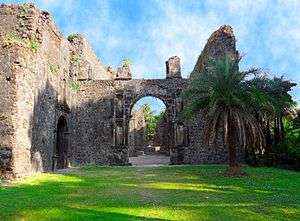 The Bassein Fort | |
 Bassein Fort | |
| Coordinates | 19°19′50.4″N 72°48′50.8″E / 19.330667°N 72.814111°E |
| Type | Seaside fort |
| Site information | |
| Owner | Government of India |
| Controlled by |
Chalukya dynasty (-1432)
|
| Open to the public | Yes |
| Condition | Ruins |
| Site history | |
| Built | 1184 |
| Built by | Yadavas of Devagiri |
| Materials | Stone |
| Battles/wars | Battle of Bassein |
Fort Bassein, also known as the Vasai Fort or Fort Baçaim (Marathi: वसई चा किल्ला), is a large fort in the town of Vasai in the Palghar district of Maharashtra state in the Konkan division in India. The name "Bassein" is the English version of the Portuguese "Baçaim" (with the "ç" spoken as "s" and with the "m" silent), itself a version of an apparently native name that may have a connection to the Vasa Konkani[1] tribals of the North Konkan region, extending from Mumbai into "South Gujarat". The Marathi name of the place is Vasai.
The complete form of the Portuguese name is "Fortaleza de São Sebastião de Baçaím" or the Fort of St. Sebastian of Vasai. The fort is a monument of national importance and is protected by the Archaeological Survey of India.[2]
The fort and the town are accessible via the Vasai Road railway station which itself is in Navghar-Manikpur, a part of the city of Vasai-Virar, and lies to the immediate north of the city of Mumbai and Mira Road in Bhayandar. The Vasai Road railway station is on the Western Railway line (formerly the Mumbai, Baroda and Central India Railway) in the direction of the Virar railway station.
History
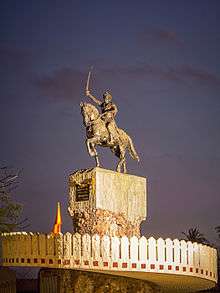
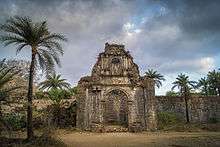
Pre-Portuguese Era
The Greek merchant Cosma Indicopleustes is known to have visited the areas around Bassein in the 6th century and the Chinese traveller Xuanzang later on June or July 640. According to historian José Gerson da Cunha, during this time, Bassein and its surrounding areas appeared to have been ruled by the Chalukya dynasty of Karnataka.[3] Until the 11th century, several Arabian geographers had mentioned references to towns nearby Bassein, like Thana and Sopara, but no references had been made to Bassein.[4] Bassein was later ruled by the Silhara dynasty of Konkan and eventually passed to the Seuna dynasty. It was head of district under the Seuna (1184-1318). Later being conquered by the Gujarat Sultanate,[5] a few years later Barbosa (1514) described it under the name Baxay (pronounced Basai) as a town with a good seaport belonging to the king of Gujarat.[6]
Portuguese Era
The Portuguese first reached the west coast of India when the Portuguese explorer Vasco da Gama landed at Calicut in 1498. For several years after their arrival in India, they had been consolidating their power in north Konkan. They had established a strong foothold in Goa, which they captured from the Sultan of Bijapur in 1510. According to historian Manuel de Faria e Sousa, the coast of Bassein was first visited by the Portuguese in 1509, when Francisco de Almeida on his way to Diu captured a Muslim ship in the harbour of Mumbai, with 24 citizens of Gujarat aboard.

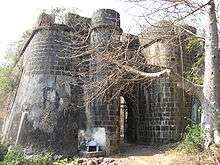
Treaty of Bassein (1534)
The Treaty of Bassein (1534) was signed by Sultan Bahadur of Gujarat and the Kingdom of Portugal on 23 December 1534 while on board the galleon São Mateus. Based on the terms of the agreement, the Portuguese Empire gained control of the city of Bassein, as well as its territories, islands, and seas. The Mumbai Islands under Portuguese control include Colaba, Old Woman's Island, Mumbai, Mazagaon, Worli, Matunga, and Mahim. Salsette, Daman and Diu, Thane, Kalyan, and Chaul were other territories controlled and settled by the Portuguese.
At the time, the cession of Mumbai was of minor importance - but retroactively it gained a crucial importance when the place passed from the Portuguese to the British in 1661 as part of the dowry of Catherine of Braganza and became a major trade centre - making this the treaty's most important long-term result. Bassein was the Portuguese northern capital at the time of the 16th-century treaty with the Sultan.
Under Portuguese India, the fort was the Northern Court or "Corte da Norte", second only to the city of Goa, functioning as the headquarters of the Captain of the North. For approximately 150 years, the presence of the Portuguese made the surrounding area a vibrant and opulent city.[7][8] As such it was the capital of Portuguese possessions on the coast north of Goa, over places such as Chaul-Revdanda, Karanja Island, the Mumbai Archipelago, Bandra Island, Juhu Island, Salsette Island including the city of Thane, Dharavi Island, the Vasai archipelago, Daman, Diu and other Portuguese holdings extending up the coasts to Pakistan, Oman, the UAE, Iran and other parts of the Persian Gulf.
The ethnic community locally known in the Mumbai region as the "East Indians" were called "Norteiro" (Northern men) after the Court of the North functioning out of the fort.
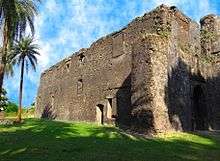
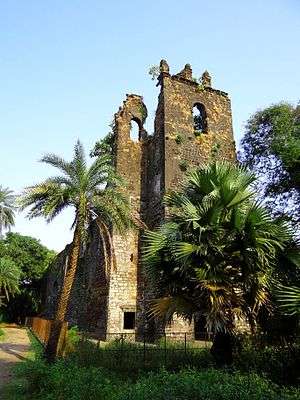
Maratha Era
In the 18th century, the Bassein Fort was taken over by the Maratha Empire under Peshwa Baji Rao's brother Chimaji Appa and fell in 1739 after the Battle of Baçaim. The fort was taken by British in 1774 and returned to Maratha in 1783 under the Treaty of Salbai. The British in 1818 attacked and again took over the territory from the Marathas. The fort also played a strategic role in the First Anglo-Maratha War.[9]
British Era
Treaty of Bassein (1802)
The Treaty of Bassein (1802) was a pact signed on 31 December 1802 between the British East India Company and Baji Rao II, the Maratha Peshwa of Pune (Poona) in India after the Battle of Poona. The treaty was a decisive step in the dissolution of the Maratha Empire.
Present
The fort is a major tourist attraction in the region for its Indo-Portuguese history. The ramparts overlook what is alternatively called the Vasai Creek and the Bhayandar Creek and are almost complete, though overgrown by vegetation. Several watch-towers still stand, with safe staircases leading up. The Portuguese buildings inside the fort are in ruins, although there are enough standing walls to give a good idea of the floor plans of these structures. Some have well-preserved façades. In particular, many of the arches have weathered the years remarkably well. They are usually decorated with carved stones, some weathered beyond recognition, others still displaying sharp chisel marks.
Three chapels inside the fort are still recognisable. They have façades typical of 17th-century Portuguese churches. The southernmost of these has a well-preserved barrel-vaulted ceiling. Besides all the structures, tourists often also observe the nature that has taken over much of the fort. Butterflies, birds, plants and reptiles can all be observed.
The fort is also a popular shooting location for Bollywood movies and songs. The Bollywood hit ″Kambakkht Ishq″ from Pyaar Tune Kya Kiya is one of the Bollywood songs. Movies such as Josh, starring Shah Rukh Khan, and Love Ke Liye Kuch Bhi Karega have a number of scenes from the fort. Other films shot here include Khamoshi and Ram Gopal Verma's Aag. The fort was also one of the shooting locations for the international hit song 'Hymn for the Weekend' by British band Coldplay. The fort showcased at the start and in between is the Bassein Fort.[10][11] The video features Beyoncé and Indian actress Sonam Kapoor.[12] The video has over 960 million views on YouTube as of July 2018, becoming the second most-viewed music video for Coldplay (after "Something Just like This").
The Archaeological Survey of India has started restoration work of the fort, although the quality of the work has been severely criticised by "conservation activists".
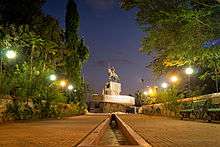
Accessibility
To visit the Bassein Fort, take a Western Railways train bound to Virar from Churchgate in Mumbai and alight at the Vasai Road Railway Station. If you are departing from the Central Railway or Central Railway Harbour Line, then you have to switch to the Western Railway line at either Dadar, Bandra or Andheri. Another railway line connects the Central and the Western Railways lines from Vasai Road Railway Station to Diva, a stop just beyond Thane city on the Central Railway line, and long-distance passenger trains travelling this route also carry commuters between the two lines. There is a railway station named Kopar between Diva and Dombivli. Passengers travelling from Thane or Kalyan can alight at Kopar and walk up the staircase and to Platform No. 3 where they can catch the Diva to Vasai train. The Vasai Road station is only an hour by train from Kopar station. Currently, there are 5 trains daily which goes to Vasai Road from Dombivli, Diva and Panvel and 5 trains from Vasai Road to Diva and Panvel. There is a State Road Transport Bus Terminus & Station adjacent and to the immediate west of the Vasai Road Railway Station in Manickpur-Navghar. The destination for buses going to the Bassein Fort is "Killa Bunder" or "Fort Jetty/Quay". There are buses every half-hour. Ticket cost ₹15 per person and you can alight at the last stop and walk around. Auto rickshaws are also available, which can be hired from the western entrance to the railway station but cost more per head and are regarded as unsafe in that they are usually congested. Auto rickshaws are also available, which can be hired from the main road outside the station but it will usually cost you ₹20 per person.[13]
Gallery
Some fauna and flora inside the fort:
 Baobab tree at the seaside entrance
Baobab tree at the seaside entrance
 Baby caterpillars feeding on leaves
Baby caterpillars feeding on leaves Some wildflowers
Some wildflowers Spider from the Araneidae family feasting on a butterfly
Spider from the Araneidae family feasting on a butterfly
 African Hoopoe
African Hoopoe Agamid Lizard
Agamid Lizard
See also
- Military history of Bassein
- Treaty of Bassein (1534)
- Treaty of Bassein (1802)
- Portuguese India
- Chimaji Appa
- Battles involving the Maratha Empire
- List of Maratha dynasties and states
- List of people involved in the Maratha Empire
- Marathi People
- Maratha Army
- Maratha Navy
- Maratha titles
- Military history of India
- List of forts in Maharashtra
- List of forts in India
References
- ↑ Lúcio, Mascarenhas (16 August 2003). "Konkani Roots". Lúcio Mascarenhas, formerly "Prakash". Archived from the original on 24 July 2018. Retrieved 25 July 2018.
- ↑ Monument #110, Mumbai Circle, ASI: http://asi.nic.in/asi_monu_alphalist_maharashtra_mumbai.asp
- ↑ Da Cunha 1999, p. 129
- ↑ Da Cunha 1999, p. 130
- ↑ Da Cunha 1999, p. 131
- ↑ "Chapter 19: Places". Thane District Gazetteer. 20 December 2006. Retrieved 25 July 2018.
- ↑ "Vasai Fort". Maharashtra Tourism. Archived from the original on 17 September 2015. Retrieved 25 July 2018.
- ↑ "Vasai Fort". Maharashtra Tourism. Retrieved 25 July 2018.
- ↑ Naravane, M. S. (2014). Battles of the Honourable East India Company: Making of the Raj. India: APH Publishing Corporation. p. 60. ISBN 9788131300343.
- ↑ Mor, Ben (29 January 2016). "Ben Mor on Instagram". Instagram. Retrieved 25 July 2018.
- ↑ "Black Dog Films on Instagram". Instagram. Black Dog Films. 29 January 2016. Retrieved 25 July 2018.
- ↑ Lohana, Avinash (28 January 2016). "Sonam and Beyonce feature in new 'Coldplay' single". The Times of India. Archived from the original on 16 October 2017. Retrieved 25 July 2018.
- ↑ "Vasai Fort - How to go, places to visit, things to do". Time to Travel. 1 January 2010. Archived from the original on 5 February 2018. Retrieved 25 July 2018.
External links
Bibliography
- Rossa, Walter (2012). "Vasai Fort: Historical Background and Urbanism". Heritage of Portuguese Influence. Retrieved 29 July 2015.
- Mendiratta, Sidh Losa (2012). "St. Sebastian Fort: Military Architecture". Heritage of Portuguese Influence. Retrieved 29 July 2015.
- Mendiratta, Sidh Losa (2012). "Dispositivos do Sistema Defensivo da Província do Norte do Estado da Índia (1521-1739)". PhD Thesis, Coimbra University.
Coordinates: 19°19′49″N 72°48′54″E / 19.33028°N 72.81500°E